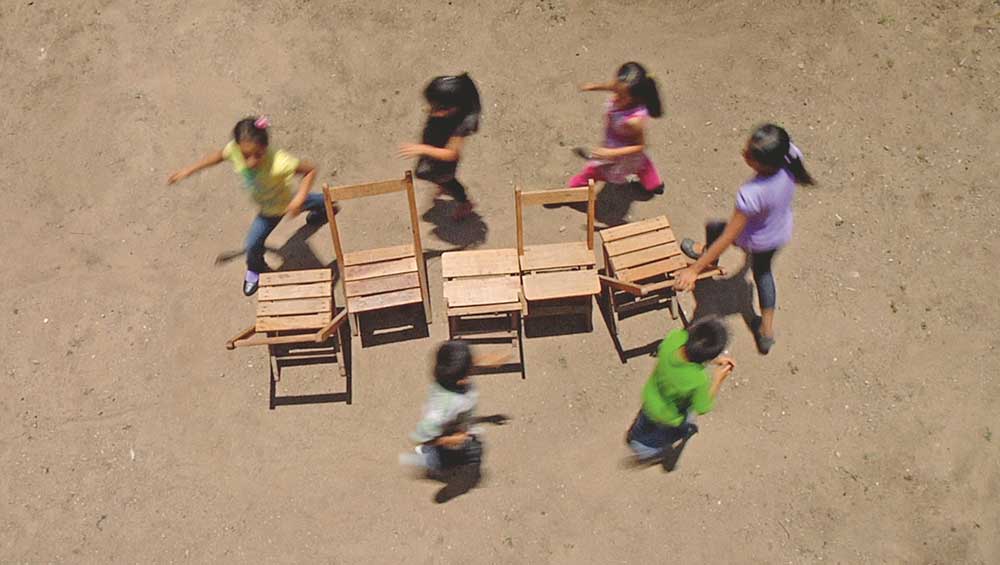
Francis Alÿs, Children’s Game #12: Musical Chairs, Oaxaca, Mexico, 2012. In collaboration with Elena Pardo and Félix Blume.
Barbican Art Gallery, London
27 June – 1 September 2024
by JOE LLOYD
Games are at least as old as humanity. Ricochets, the Belgian artist Francis Alÿs’s exhibition at the Barbican Art Gallery, features an illustrated capsule history of play arranged around the upper floor parapet. There is an image from a kylix of an ancient Greek boy playing yo-yo, Goya’s cartoon of boys playing soldiers, and a tablet from Mesopotamia from about 1500BC that describes skipping ropes, hiding, running and wrestling, among other recreations. One panel quotes the UN Convention on the rights of the child: “States Parties recognise the right of the child … to engage in play and recreational activities.”
Over the balcony’s edge, we see dozens of children exercising that right. About 30 screens each show a short film of children engaging in play. The gallery has been transformed into a playground. There is a soundtrack of cries and calls, thwacks and thuds. Visitors can sit on swivel stools and wheel them around from game to game. Alÿs’s delicate, gem-like pairings are dotted around, often showing scenes where mundane day-to-day activities collide with danger. The films form his Children’s Games series (1999-), perhaps the most rigorous attempt to catalogue youthful play since Pieter Bruegel the Elder’s 1560 painting. But whereas Alÿs’s sort-of-countryman chronicled the games of a Flemish village, Alÿs spans the world.
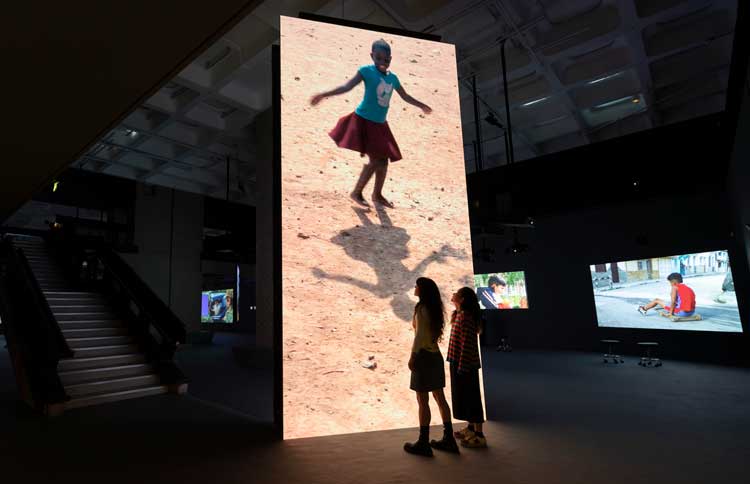
Francis Alÿs: Ricochets, installation view, Barbican Art Gallery, 27 June – 1 September 2024 © Jemima Yong / Barbican Art Gallery.
We see games that cross international borders: hopscotch in Mosul, grandma’s footsteps in London, jump rope in Hong Kong. Others have a local specificity, such as nzango: a female-only game in the Democratic Republic of the Congo in which girls try to anticipate the leg movements of their opponent, to the sound of ever-accelerating singing and clapping. Alÿs’s native Belgium plays host to slakken or snail-racing, where gastropods are randomly picked up and placed in the centre of a roughly drawn chalk circle. Their shells are daubed with paint to mark them out. Children speculate on the molluscs’ motivations. The result is slow-motion chaos, as snails crawl over each other, until eventually two frontrunners cross the line at once. A sudden rain shower then washes the paint away.
Born in Antwerp, Alÿs grew up in the sort of gently rolling countryside depicted by Bruegel. He describes his own childhood as a time of complete freedom. His career as an artist has its own emancipatory aspects. He trained as an architect, then moved to Mexico City to work for non-governmental organisations. There, he gradually became involved in the city’s growing contemporary art scene, which sometimes resembled adult versions of the sort of play that he depicts. He has pushed a block of ice through Mexico City for nine hours, chased after “dust devils”, worn an unravelling jumper, and drawn a line green of paint through Jerusalem along the ceasefire boundary drawn up in 1948 at the end of the Arab-Israeli war.
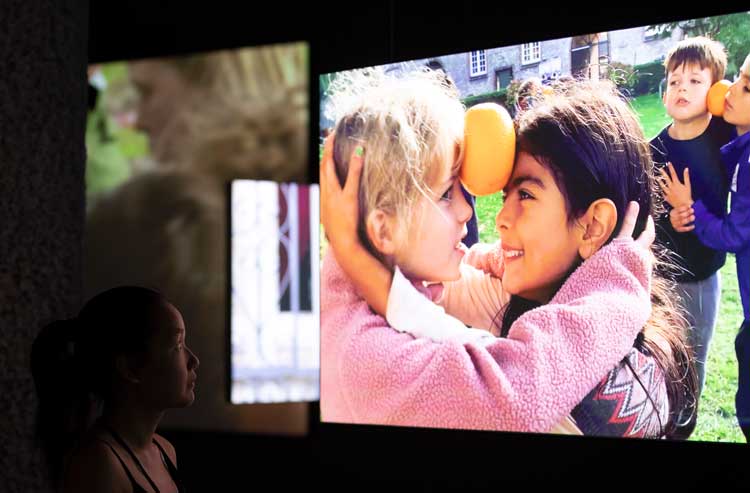
Francis Alÿs: Ricochets, installation view, Barbican Art Gallery, 27 June – 1 September 2024 © Jemima Yong / Barbican Art Gallery.
For Children’s Games, he steps behind the camera. He films games, with children’s consent, that he has espied on his travels across the world. The games must use no special equipment and require no great set-up. Maybe there is an element of voyeurism here, a glimpse into private worlds. A painting placed by the exhibition door shows numerous eyes stare out, as if they are children returning our gaze.
But Alÿs shows nothing but respect for his subjects. We call simple tasks child’s play, but Alÿs’s work shows the imagination and ambition that goes into improvising and performing games. Playing is experimenting. “They often are about invention,” writes Alÿs. There are games of chance and games of skill. Sometimes, everyday household materials are transformed into objects of play. One video from Oaxaca in Mexico shows children playing musical chairs in a dusty yard. On other occasions they use nature, skimming little stones across the surface of the water in Morocco. And sometimes they use nothing at all. Upstairs, a small screen shows Siren (2023), an independent artwork. It depicts Ukrainian children playing Air Raid Alert, a game in which the children imitate the sound of an air siren. It is difficult to watch, and for some children, difficult to perform.
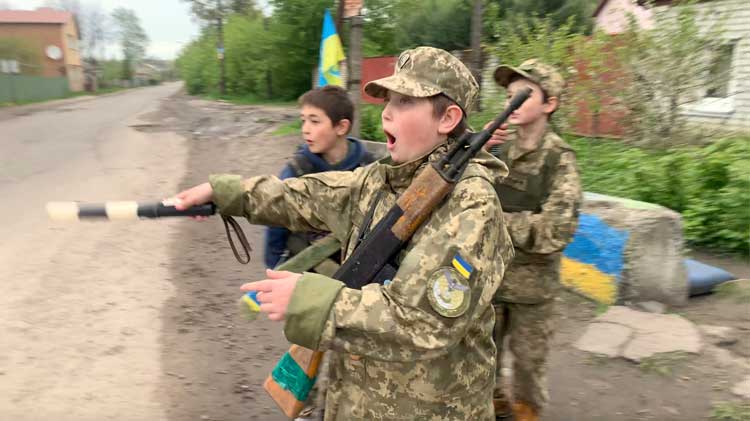
Francis Alÿs, Children’s Game #39: Parol, Kharkiv, Ukraine, 2023 In collaboration with Julien Devaux, Félix Blume, and Hanna Tsyba.
One particularly extraordinary film, granted its own separate room, shows a group of boys meet just a few days after the East Bank of Mosul was freed from the Islamic State. A casual street football match begins. One boy is wearing a Diego Costa shirt, another a Neymar one. Every now and then they stop for a truck or a moped to use the road. The game could happen anywhere in the world. But here it is surrounded by ruined buildings and burnt-out vehicles. And, even more extraordinarily, they are playing without a ball. The teenagers enact a graceful, almost musical performance of kicks, dives and headers, with the synchronicity of a dance troupe. The action ends with the sound of distant gunfire. Football was banned as haram under Islamic State. A message on the video tells us that, a few years before, 13 boys were publicly executed for watching a football match on TV.
Games can be acts of resistance. A boy flies a kite in Afghanistan in 2011, previously – and now once more – banned by the Taliban. Play can be a way to persevere through violent times. Alÿs shoots hopscotch in a Mosul refugee camp. In Kharkiv, Ukraine, children pretend to be hunting Russian spies. Dressed in fatigues and wielding makeshift wooden “guns”, they stop cars and request ID, search trunks and ask for a password – palyanitsya – that Russians find difficult to pronounce. While games provide refuge from violence, they also imitate it. Children in Hackney, east London, play conkers, smashing chunks out of horse chestnut seeds. The flip side of the screen takes us to Havana, Cuba, where the game chapitas sees bottle caps crushed and sharpened, threaded with a string. Boys and girls compete to slash their opponent’s thread, in a game that quickly comes to resemble combat. Does the drive towards conflict sprout from youthful frolics?
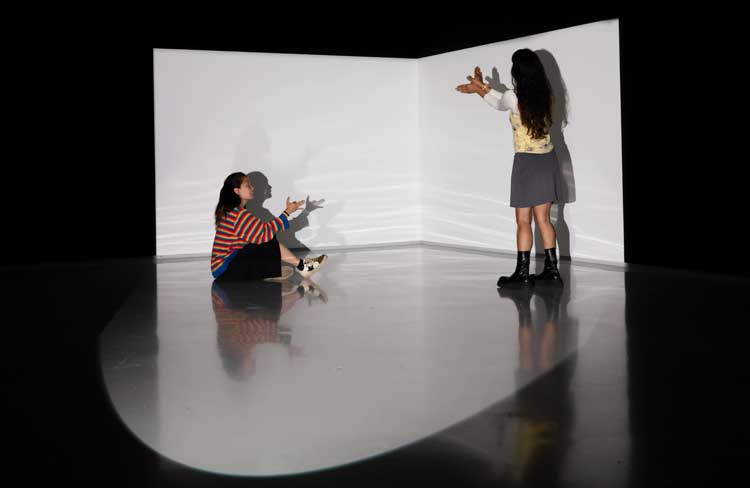
Francis Alÿs: Ricochets, installation view, Barbican Art Gallery, 27 June – 1 September 2024 © Jemima Yong / Barbican Art Gallery.
The voluminous Barbican Art Gallery sometimes lends itself to overstuffed exhibitions. But here the balance is just right. The hubbub of the ground-floor gallery is counterpoised by the spaciousness of the second floor. There are two rooms where visitors can play for themselves, spinning around on pebble-like platforms or creating shadow puppets. One darkened room contains a single tiny painting showing a boy holding his face against a tree trunk, as if preparing for hide and seek. Others contain fluid line animations of disembodied limbs engaged in play. In one, legs swing as if from a tree. Thumbs go to war, hands stack up, and fingers transform into birds and rabbits in shadow-play. These works feel like a silent gloss on the films below, distilling play and games to simple gestures and motions. It seems miraculous that our bodies and minds can do so much with so little.